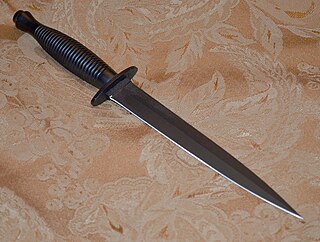
A dagger is a fighting knife with a very sharp point and usually one or two sharp edges, typically designed or capable of being used as a cutting or thrusting weapon. Daggers have been used throughout human history for close combat confrontations, and many cultures have used adorned daggers in ritual and ceremonial contexts. The distinctive shape and historic usage of the dagger have made it iconic and symbolic. A dagger in the modern sense is a weapon designed for close-proximity combat or self-defense; due to its use in historic weapon assemblages, it has associations with assassination and murders. Double-edged knives, however, play different sorts of roles in different social contexts.
A sword is an edged, bladed weapon intended for manual cutting or thrusting. Its blade, longer than a knife or dagger, is attached to a hilt and can be straight or curved. A thrusting sword tends to have a straighter blade with a pointed tip. A slashing sword is more likely to be curved and to have a sharpened cutting edge on one or both sides of the blade. Many swords are designed for both thrusting and slashing. The precise definition of a sword varies by historical epoch and geographic region.

The kris or keris is a Javanese asymmetrical dagger with a distinctive blade-patterning achieved through alternating laminations of iron and nickelous iron (pamor). The kris is famous for its distinctive wavy blade, although many have straight blades as well, and is one of the weapons commonly used in the pencak silat martial art native to Indonesia. Kris have been produced in many regions of Indonesia for centuries, but nowhere—although the island of Bali comes close—is the kris so embedded in a mutually-connected whole of ritual prescriptions and acts, ceremonies, mythical backgrounds and epic poetry as in Central Java. Within Indonesia the kris is commonly associated with Javanese culture, although other ethnicities in it and surrounding regions are familiar with the weapon as part of their cultures, such as the Balinese, Sundanese, Malay, Madurese, Banjar, Buginese, and Makassar people. The kris itself is considered as a cultural symbol of Indonesia and also neighbouring countries like Brunei, Malaysia, Philippines, Singapore, and Thailand.
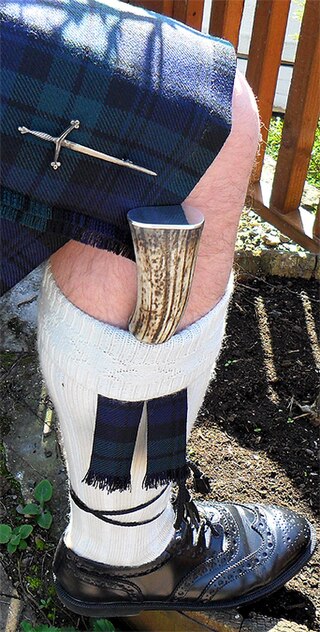
The sgian-dubh – also anglicized as skene-dhu – is a small, single-edged knife worn as part of traditional Scottish Highland dress. It is now worn tucked into the top of the kilt hose with only the upper portion of the hilt visible. The sgian-dubh is normally worn on the same side as the dominant hand.

A trench knife is a combat knife designed to kill or incapacitate an enemy at close quarters, such as in a trench or other confined area. It was developed as a close combat weapon for soldiers attacking enemy trenches during the First World War. An example of a World War I trench knife is the German Army's Nahkampfmesser.

A pistol sword is a sword with a pistol or revolver attached, usually alongside the blade. It differs from a rifle with a bayonet attached, in that the weapon is designed primarily for use as a sword, and the firearm component is typically considered a secondary weapon designed to be an addition to the blade, rather than the sword being a secondary addition to the pistol. In addition, the two components of these weapons typically cannot be separated, unlike most bayonets mounted on rifles.
The pugio was a dagger used by Roman soldiers as a sidearm. It seems likely that the pugio was intended as an auxiliary weapon, but its exact purpose for the soldier remains unknown. Officials of the empire took to wearing ornate daggers in the performance of their offices, and some would wear concealed daggers for defense in contingencies. The dagger was a common weapon of assassination and suicide; for example, the conspirators who stabbed Julius Caesar used pugiones. The pugio developed from the daggers used by the Cantabrians of the Iberian peninsula.

The patta is a sword, originating from the Indian subcontinent, with a gauntlet integrated as a handguard. Often referred to in its native Marathi as a dandpatta, it is commonly called a gauntlet-sword in English.

The aruval is a type of billhook machete from southern India, particularly common in the Indian states of Tamil Nadu Andhra Pradesh and Kerala. It is also known as the koḍuvāḷ or the machchu longu. It is a type of long sickle with a knife-like scythe-handle, and is used both as a tool and a weapon. Tamils revere the weapon as a symbol of Karupannar. In popular culture, it is sometimes associated with gangsters, especially in the Rayalaseema region. In Kerala, its primary use is for agriculture, mainly in coconut cutting, clearing pathways, cutting wood and other uses.

A jambiya, is a specific type of dagger with a short curved blade with a medial ridge that originated from the Hadhramaut region in Yemen. They have spread to other countries in the Middle East, to other countries in the Arab world, and to parts of South Asia and Southeast Asia. Men typically above the age of 14 wear it as an accessory to their clothing.

A push dagger is a short-bladed dagger with a "T" handle designed to be grasped and held in a closed-fist hand so that the blade protrudes from the front of the fist, either between the index and middle fingers or between the two central fingers, when the grip and blade are symmetrical.
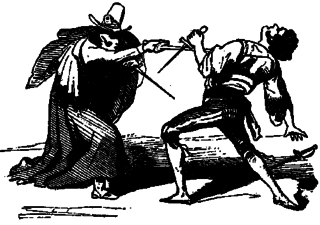
The parrying dagger is a category of small handheld weapons from the European late Middle Ages and early Renaissance. These weapons were used as off-hand weapons in conjunction with a single-handed sword such as a rapier. As the name implies they were designed to parry, or defend, more effectively than a simple dagger form, typically incorporating a wider guard, and often some other defensive features to better protect the hand as well. They may also be used for attack if an opportunity arises. The general category includes two more specific types, the swordbreaker and trident dagger.
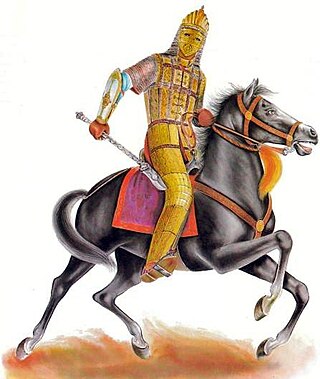
A bhuj or kaat is a type of knife or dagger from Gujarat and Sindh. It is commonly called an axe-knife, because the blade is fixed onto an axe-like haft. The weapon takes its name from the city of Bhuj in the Kutch district of the state of Gujarat, where it originated, though it may have also originated in Sindh. The bhuj is short, broad, stout, and heavy, with a mild curve. It often sports an engraved and gilded mount, inlaid haft and decorated knob. This knob is typically a stylized elephant head. The short re-curved blade measures 7–10 in (180–250 mm) long, and its copper sheath makes the weapon 20 in (510 mm) long in total. It is mostly single-edged, except for a slight rear edge at the tip. The blade is mounted at a right angle to a metal haft in a manner similar to a long axe. The haft is sometimes hollow, concealing another small stiletto-like dagger. The weapon is similar to the Punjabi gandasa or the European glaive. The weapon was popular among the Sindhi cavalry of the Soomra and Samma dynasties of Sindh.

The bichuwa or bichawa is a dagger, originating from the Indian subcontinent, with a loop hilt and a narrow undulating sharp blade. It is named for its resemblance to the sting of a scorpion, for which the Hindi name is bichuwa. The weapon was based on the maduvu, or horn dagger created in South India, and many bichuwa have blades which retain the shape of buffalo horns. Early examples of the bichuwa come from the medieval southern Karnataka empire of Vijayanagara. Being relatively easy to make, the bichuwa has persisted into the 20th century as a decorative dagger.
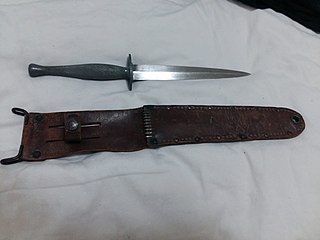
The United States Marine Raider stiletto was issued to the Marine Raiders and 1st Canadian Parachute Battalion during World War II.
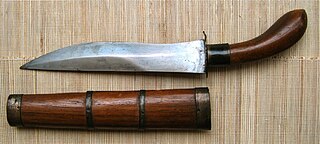
The gunong is a knife from Mindanao and the Visayas islands of the Philippines. In ancient past, it was called bunong by the Tagalog people. It is essentially a diminutive form of the larger kalis or kris. The gunong serves both as a utility knife and as a thrusting weapon used for close quarter fighting—usually as a last defense. It is most often associated with the Maranao, among whom the gunong was traditionally carried by both sexes, although it exists in other cultures throughout Mindanao and the Visayas. The weapon is generally tucked into the back of a waist sash.
A billao, also known as a belawa, is a horn-hilted Somali shortsword or long dagger depending on blade length. It served most notably as a close-quarters weapon in the Dervish State, at the turn of the 20th century.

The pesh-kabz or peshkabz is a type of Indo-Persian knife designed to penetrate mail armour and other types of armour. The word is also spelled pesh-qabz or pish-ghabz and means "fore-grip" in the Persian language; it was borrowed into the Hindustani language. Originally created during Safavid Persia, it became widespread in Central Asia and the Indian subcontinent during Mughal period.

Mughal weapons significantly evolved during the ruling periods of its various rulers. During its conquests throughout the centuries, the military of the Mughal Empire used a variety of weapons including swords, bows and arrows, horses, camels, elephants, some of the world's largest cannons, muskets and flintlock blunderbusses.

The piha kaetta, also sometimes called the Kandyan knife, is a knife or dagger native to the island of Sri Lanka. A typical piha kaetta has a straight-backed blade combined with a drop-point and a curved cutting edge. Many of the finest piha kaetta knives were produced in royal workshops, show very high levels of craftsmanship, and were given to courtiers and the nobility as status symbols.


















